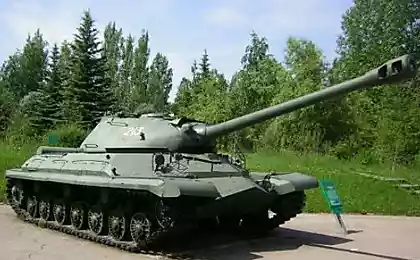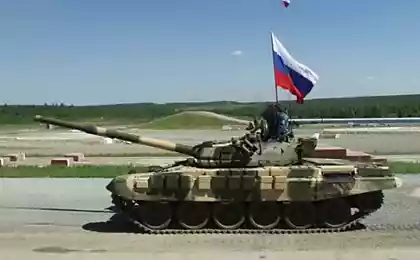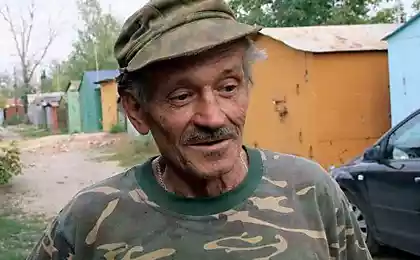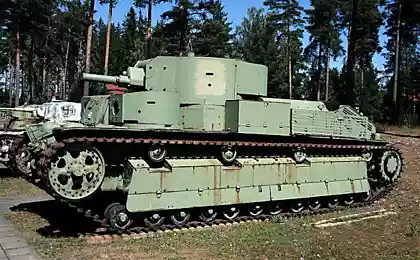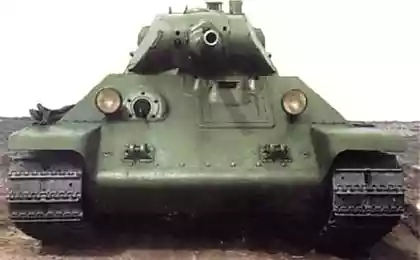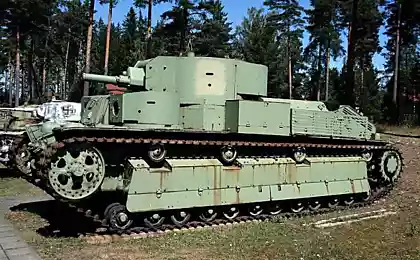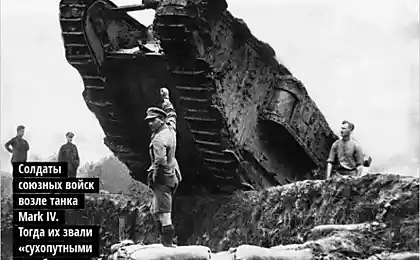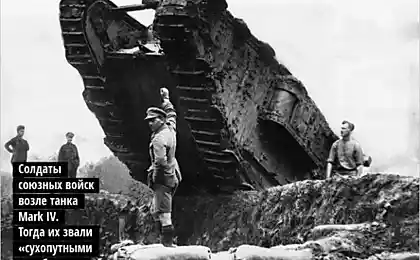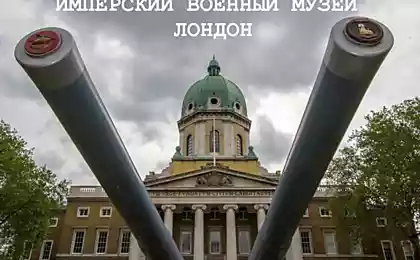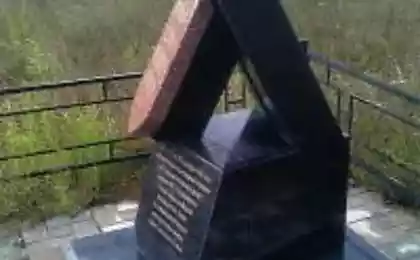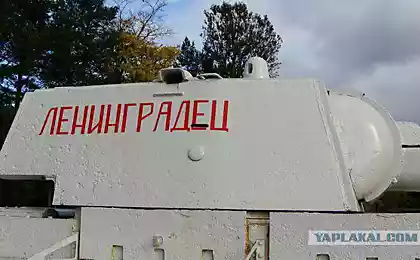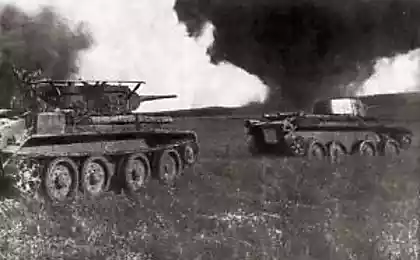1377
Legend of HF
June 23 at about 15 o'clock on the east bank Dubysa northeast of Raseiniai in a meeting engagement faced Soviet 2nd Armored Division and the German 6th Panzer Division. The Soviet tankers which destroyed about 80 fascist tanks. During this fight to the road Raseiniai-Šiluva near the turn to Daynyay broke a Soviet tank. This road was moving battle group Rous from the same 6-Panzer Division. She has been busy bridge over Dubysa and a bridgehead on the east bank. Here on this road and there was a Soviet heavy tank KV, which blocked all traffic. That's how it was described in the journal of hostilities 6th Motorized Brigade Armored Division 6: "24.6 The planned march was stopped by the division. Following the announcement of aerial reconnaissance about the concentration of large groups of enemy tanks were ordered to go on the defensive.
Offensive noticed enemy tanks was directed only against the militant group Zeckendorf. Heavy tanks (later described as a 52-ton tanks of a new model) broke through the defensive line and went to the rear. Around 9:00 it was reported that two of these giants were on our way offensive.
About 14 pm (Berlin time) to help battle group was sent Zeckendorf 65th Tank Battalion under the command of Lieutenant Colonel Schenk. Fooling the enemy forces could not, he took the fire and our foothold in the north on both sides of Dubysa small infantry battalion launched an offensive.
Suddenly, one enemy tank appeared near the command post of our brigade. He set fire to two of our truck and stopped in the middle of the road. Such audacity impressed, but then it was not known that he was stopped because of technical failures. "
Thus, according to some ZHBD we can say that there was a tank on the road June 24 at noon. Incidentally, the logfile is interesting because there is mention of the Germans of the "52-ton tanks." Without a doubt, we are talking about the tanks KV-2 only at the beginning of the war the Germans did not know their "official" name. Technical characteristics of the tanks they learned very quickly - from the captured soldiers. That report is the commander of the 41st anti-tank division:
"The crew of a Russian tank testified that listened to and recorded the interpreter they talked about his 52-ton tank. Armor thickness 85 mm, 38 mm hatch only. In the tank 15, 2-cm gun, three 7 62-mm machine gun (left two). Tanks, participated in today's battle tank, allegedly owned by the 2nd Panzer Division, which was formed in 1939 as a team and has recently launched in the division. "
Padded KV-2.
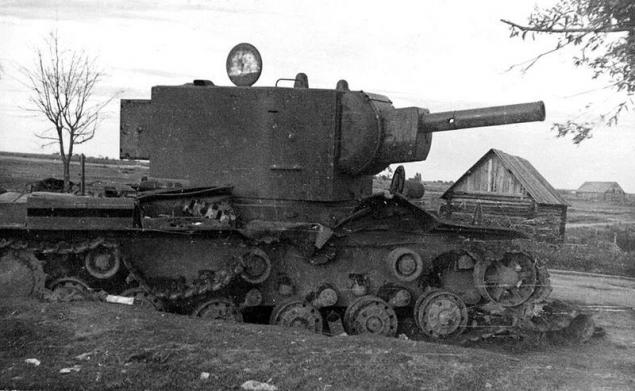
Once on the road the tank created a lot of problems for the battle group "Rouse", the command post which at that time was at 1, 5 km north-west from the tank. First of all, the tank broke the wire, so faded telephone communication with the headquarters of the division. Nobody knew whether there were other tanks, so the battle group was instructed to prepare for all-round defense. Sappers were instructed to mine the road and a reconnaissance platoon was sent immediately to scout the area. He soon found that in the vicinity of enemy tanks anymore. However, one tank and created a lot of problems. On the road it stretched a long line of cars with ammunition and food. Several of them (most authors mentions 12) tank destroyed fire your guns. Attempts to bypass the tank fields also failed. Circling the one hand, cars stuck in the sand on the other side of the road the ground was swampy, so there was impossible to overtake. It was necessary to urgently find ways to eliminate barriers.
The order was given to destroy the tank gunners 41st antitank battalion. In the book by E. Routh said that destroy the tank had said battery division, commanded by Lieutenant Vagenrot. Thus E. Raus said the nomination of anti-tank guns of four. And it was prepared before the war, anti-tank guns Cancer 40 caliber 5 cm.
Whatever it was, the Germans fired from close range and highly accurate. The fire was accurate, achieved eight hits. And when it seemed that all was over, turret slowly turned, took careful aim and methodical fire destroyed all brand new gun. With the explosion of ammunition stacked in one of the guns, artillery killed two, one was wounded.
Destroy the tank tried to field 105 mm caliber cannon. After checking the accuracy of the tank fire, this weapon did not stand for direct fire and shot at the closed position, adjusting the fire. However, this has no effect - it was necessary to get accurate and fragments of shells exploding near the tank did not cause harm.
Driving battle.
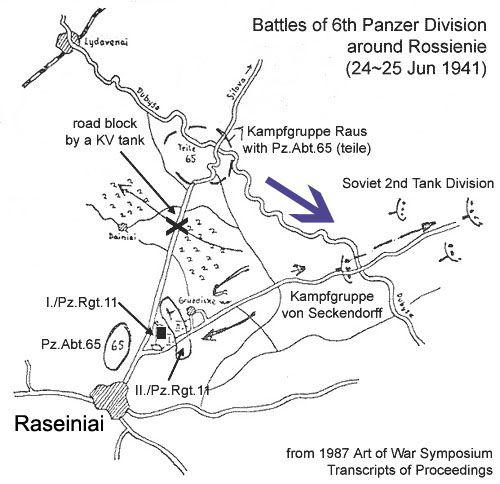
It became clear that the available funds will not be able to destroy the tank. There remained only the possibility - 88-mm anti-aircraft gun. One of them, called out Raseynyaya began cautiously to drag to the tank from the south. Himself tank was still deployed in the south, as it was on this side of it originally attacked. On the road continued to smoke set on fire trucks. Smoke prevented tankers aim was to some extent cover, giving the attacker the opportunity to approach unnoticed closer. Finally, the instrument has been chosen for the position on the edge of the woods, about 500 meters from the tank. Gunners started feverishly preparing his gun. However, it turned out that the tank really nerves of steel. When it seemed that the training tools is completed, the tank turned and fired the first tower. The shot was accurate - anti-aircraft gun had fallen into a ditch, killing several soldiers appeared, others have been forced to retreat.
The tank continued to block the road, the battle group Routh was still paralyzed, approaching night. At the headquarters of the brigade were discussed various options for destroying the tank. One of them was an attempt to blow up a tank, dragged him to the explosives. Group of engineers volunteers on the night of June 25, quietly crept up to the tank and put him two packets of explosives, one of them a little more, on the fenders, lower - at the base of the gun. But as it turned out later, the explosions did not give the expected result.
Morning came, and the tank was still blocked the road. The Germans had to go to the trick. It was decided to divert the attention of the tank crew. To the east, northeast and northwest of the tank was woodland. As it began to move Pz.35, shooting in the direction of the tank. Tankers nervous and did not notice the danger approaching from the rear.
By diverting the attention of the crew of the tank, the Germans established a firing position on the new 88-mm anti-aircraft gun. This time the gunners managed to shoot first and get into the tank. Only now noticing the danger, the crew even tried to turn the gun to the side of the Germans, but this time it got another two 88-caliber shells and tank gauging. Yet artillery for greater certainty fired him four more shells, and only then began to gather around him curious soldiers. They were surprised to see that the tank armor struck only two 88-millimeter shells and 50 shots-millimeter guns left on its case only dent ...
But this is not the end. As subsequently wrote E.Raus, German soldiers near the tank felt like little David near the fallen Goliath - tried to open the door, jerked the handle and knocked ... and reach out. The tank suddenly came to life, its trunk again moved sideways and frightened the Germans gave dёru. Not only miners were mixed. Grabbing a bunch of grenades, they threw it into the hole on the shell. Inside the tank there was an explosion, the tower hatch opened. Inside the Germans saw the bodies of six soldiers. E.Raus argues that the Germans buried the dead on the roadside with full military honors.
Military cemetery in Raseiniai.
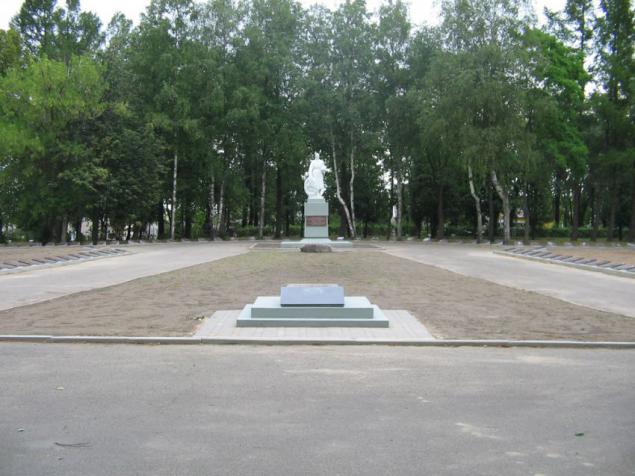
Later, they drove local residents who learned from the tank six bodies of Soviet soldiers. There they were, and was buried beside the road, not far from the scene of the battle. and documents taken by the Germans. At the reburial in 1965 in the tomb, among the nameless things were discovered elements form two commanders and two spoons. One of them cut surname: VA Smirnov, the second - three letters: SH.N.A. Apparently, the initials of the surname, name and patronymic of the soldier. The most valuable find is that establishes the identity of the characters became a cigarette case. In which we found Komsomol card, spoiled decent time. On the first page you can read only the last digits of the ticket - ... 1573. Clear name and partial name: Ershov Pav ... But there lay a receipt, which could read: "Passport Series DR 289 759, issued October 8, 1935 Pskov police department Ershov Pavel Egorovich, delivered February 11, 1940 in Chudovsky draft board."
You can hope that these data will be able to find relatives Yershov or people who knew him. Thus, we will open a new page in the life of a warrior. And perhaps through the archives, through letters Ershov Paul Zhukovsky to get to know the native names of the other crew members.
Memorial plaque to heroes.

And finally pinpoint the type of tank. German documents indicate exactly what is the tank KV-2. Kostvennym yavlyaetsya confirmation of this, and the number of crew, six people. But in the Soviet literature are more inclined to that that there was a tank KV-1. Unfortunately the photos of this tank has not been preserved. And often issued for Raseiniai HF picture belongs tank KV-2 №B-4754, lined in the battle for the city of Isle of 5 July 1941. In the course of which the crew was killed, the battalion commander Captain Ivan Rusanov. And the rest of the crew were able to come to his. But damage to the machine correspond to the damage received Raseiniai HF. Which prevents movement of the road and was quickly taken away by the Germans.
Soviet tank KV-2 №B-4754, lined in the battle for the city of Isle. Tank RASEINIAI should look about the same.
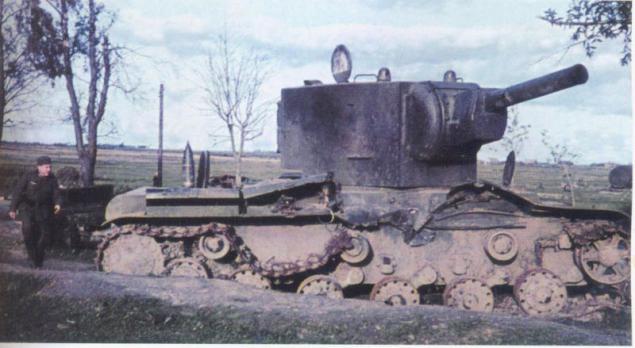
Source:
Offensive noticed enemy tanks was directed only against the militant group Zeckendorf. Heavy tanks (later described as a 52-ton tanks of a new model) broke through the defensive line and went to the rear. Around 9:00 it was reported that two of these giants were on our way offensive.
About 14 pm (Berlin time) to help battle group was sent Zeckendorf 65th Tank Battalion under the command of Lieutenant Colonel Schenk. Fooling the enemy forces could not, he took the fire and our foothold in the north on both sides of Dubysa small infantry battalion launched an offensive.
Suddenly, one enemy tank appeared near the command post of our brigade. He set fire to two of our truck and stopped in the middle of the road. Such audacity impressed, but then it was not known that he was stopped because of technical failures. "
Thus, according to some ZHBD we can say that there was a tank on the road June 24 at noon. Incidentally, the logfile is interesting because there is mention of the Germans of the "52-ton tanks." Without a doubt, we are talking about the tanks KV-2 only at the beginning of the war the Germans did not know their "official" name. Technical characteristics of the tanks they learned very quickly - from the captured soldiers. That report is the commander of the 41st anti-tank division:
"The crew of a Russian tank testified that listened to and recorded the interpreter they talked about his 52-ton tank. Armor thickness 85 mm, 38 mm hatch only. In the tank 15, 2-cm gun, three 7 62-mm machine gun (left two). Tanks, participated in today's battle tank, allegedly owned by the 2nd Panzer Division, which was formed in 1939 as a team and has recently launched in the division. "
Padded KV-2.

Once on the road the tank created a lot of problems for the battle group "Rouse", the command post which at that time was at 1, 5 km north-west from the tank. First of all, the tank broke the wire, so faded telephone communication with the headquarters of the division. Nobody knew whether there were other tanks, so the battle group was instructed to prepare for all-round defense. Sappers were instructed to mine the road and a reconnaissance platoon was sent immediately to scout the area. He soon found that in the vicinity of enemy tanks anymore. However, one tank and created a lot of problems. On the road it stretched a long line of cars with ammunition and food. Several of them (most authors mentions 12) tank destroyed fire your guns. Attempts to bypass the tank fields also failed. Circling the one hand, cars stuck in the sand on the other side of the road the ground was swampy, so there was impossible to overtake. It was necessary to urgently find ways to eliminate barriers.
The order was given to destroy the tank gunners 41st antitank battalion. In the book by E. Routh said that destroy the tank had said battery division, commanded by Lieutenant Vagenrot. Thus E. Raus said the nomination of anti-tank guns of four. And it was prepared before the war, anti-tank guns Cancer 40 caliber 5 cm.
Whatever it was, the Germans fired from close range and highly accurate. The fire was accurate, achieved eight hits. And when it seemed that all was over, turret slowly turned, took careful aim and methodical fire destroyed all brand new gun. With the explosion of ammunition stacked in one of the guns, artillery killed two, one was wounded.
Destroy the tank tried to field 105 mm caliber cannon. After checking the accuracy of the tank fire, this weapon did not stand for direct fire and shot at the closed position, adjusting the fire. However, this has no effect - it was necessary to get accurate and fragments of shells exploding near the tank did not cause harm.
Driving battle.

It became clear that the available funds will not be able to destroy the tank. There remained only the possibility - 88-mm anti-aircraft gun. One of them, called out Raseynyaya began cautiously to drag to the tank from the south. Himself tank was still deployed in the south, as it was on this side of it originally attacked. On the road continued to smoke set on fire trucks. Smoke prevented tankers aim was to some extent cover, giving the attacker the opportunity to approach unnoticed closer. Finally, the instrument has been chosen for the position on the edge of the woods, about 500 meters from the tank. Gunners started feverishly preparing his gun. However, it turned out that the tank really nerves of steel. When it seemed that the training tools is completed, the tank turned and fired the first tower. The shot was accurate - anti-aircraft gun had fallen into a ditch, killing several soldiers appeared, others have been forced to retreat.
The tank continued to block the road, the battle group Routh was still paralyzed, approaching night. At the headquarters of the brigade were discussed various options for destroying the tank. One of them was an attempt to blow up a tank, dragged him to the explosives. Group of engineers volunteers on the night of June 25, quietly crept up to the tank and put him two packets of explosives, one of them a little more, on the fenders, lower - at the base of the gun. But as it turned out later, the explosions did not give the expected result.
Morning came, and the tank was still blocked the road. The Germans had to go to the trick. It was decided to divert the attention of the tank crew. To the east, northeast and northwest of the tank was woodland. As it began to move Pz.35, shooting in the direction of the tank. Tankers nervous and did not notice the danger approaching from the rear.
By diverting the attention of the crew of the tank, the Germans established a firing position on the new 88-mm anti-aircraft gun. This time the gunners managed to shoot first and get into the tank. Only now noticing the danger, the crew even tried to turn the gun to the side of the Germans, but this time it got another two 88-caliber shells and tank gauging. Yet artillery for greater certainty fired him four more shells, and only then began to gather around him curious soldiers. They were surprised to see that the tank armor struck only two 88-millimeter shells and 50 shots-millimeter guns left on its case only dent ...
But this is not the end. As subsequently wrote E.Raus, German soldiers near the tank felt like little David near the fallen Goliath - tried to open the door, jerked the handle and knocked ... and reach out. The tank suddenly came to life, its trunk again moved sideways and frightened the Germans gave dёru. Not only miners were mixed. Grabbing a bunch of grenades, they threw it into the hole on the shell. Inside the tank there was an explosion, the tower hatch opened. Inside the Germans saw the bodies of six soldiers. E.Raus argues that the Germans buried the dead on the roadside with full military honors.
Military cemetery in Raseiniai.

Later, they drove local residents who learned from the tank six bodies of Soviet soldiers. There they were, and was buried beside the road, not far from the scene of the battle. and documents taken by the Germans. At the reburial in 1965 in the tomb, among the nameless things were discovered elements form two commanders and two spoons. One of them cut surname: VA Smirnov, the second - three letters: SH.N.A. Apparently, the initials of the surname, name and patronymic of the soldier. The most valuable find is that establishes the identity of the characters became a cigarette case. In which we found Komsomol card, spoiled decent time. On the first page you can read only the last digits of the ticket - ... 1573. Clear name and partial name: Ershov Pav ... But there lay a receipt, which could read: "Passport Series DR 289 759, issued October 8, 1935 Pskov police department Ershov Pavel Egorovich, delivered February 11, 1940 in Chudovsky draft board."
You can hope that these data will be able to find relatives Yershov or people who knew him. Thus, we will open a new page in the life of a warrior. And perhaps through the archives, through letters Ershov Paul Zhukovsky to get to know the native names of the other crew members.
Memorial plaque to heroes.

And finally pinpoint the type of tank. German documents indicate exactly what is the tank KV-2. Kostvennym yavlyaetsya confirmation of this, and the number of crew, six people. But in the Soviet literature are more inclined to that that there was a tank KV-1. Unfortunately the photos of this tank has not been preserved. And often issued for Raseiniai HF picture belongs tank KV-2 №B-4754, lined in the battle for the city of Isle of 5 July 1941. In the course of which the crew was killed, the battalion commander Captain Ivan Rusanov. And the rest of the crew were able to come to his. But damage to the machine correspond to the damage received Raseiniai HF. Which prevents movement of the road and was quickly taken away by the Germans.
Soviet tank KV-2 №B-4754, lined in the battle for the city of Isle. Tank RASEINIAI should look about the same.

Source:
